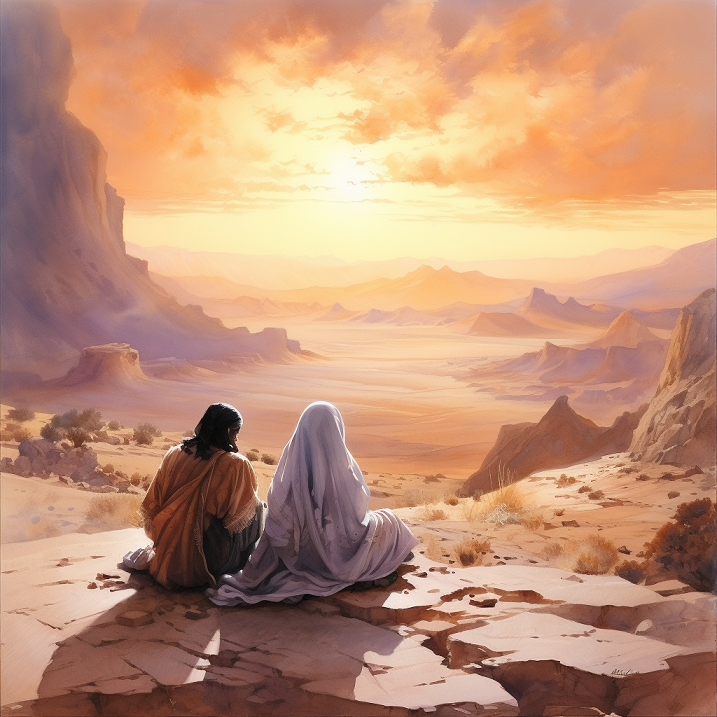In his pioneering work, “The Arab of the Desert,” H.R.P. Dickson offers an intricate and vivid portrayal of the bedouin people, an indigenous nomadic group inhabiting the areas around Kuwait and the broader Arabian Peninsula in the early 20th century. This ethnographic masterpiece delves into the nuanced and complex tapestry of their lives, beliefs, and customs, providing an unparalleled window into a world that, at the time, was largely unknown to the Western audience.
Dickson, with a keen eye for detail and a deep respect for the subject matter, crafts a narrative that is as educational as it is engaging, illuminating the cultural, religious, and social dynamics of the bedouin society.
Religious Beliefs and Practices of the Bedouin
In the intricate social fabric of the Bedouin, religion plays a pivotal role, deeply influencing their daily lives and practices. As Dickson meticulously observes, the bedouin predominantly adhere to Sunni Islam, specifically aligning themselves with either the Hanbali or Maliki schools of thought. This religious orientation distinctly sets them apart from the Shi’ahs of Iraq, the Zaidis of Yaman, and the Biyathiyahs of Oman, highlighting the rich diversity within the Islamic faith across different regions.
Dickson notes the profound integration of faith in the everyday language and actions of the bedouin. Their speech is consistently imbued with references to God, underscoring a deep-seated reverence and reliance on the divine. Phrases such as “By God” (Wallah, Billah,), “In the peace of God” (Fi’aman Illah), and others are not mere linguistic ornaments but are reflective of a culture where faith is seamlessly woven into the very fabric of existence. These expressions, used to emphasise truth, seek blessings, and express trust in God, are a testament to the central role of religion in shaping their worldview and interactions.
The Concept of the Will of God in Bedouin Society
Dickson delves into the concept of the will of God, a cornerstone of the Bedouin belief system, with a focus that reveals its profound impact on their societal and personal conduct. The Bedouin, as Dickson notes, holds a stoic belief in the divine ordination of both good and evil, seeing the hand of God in all aspects of life. This deep-rooted belief is not just theoretical but manifests in a tangible stoicism and resignation in the face of life’s trials and tribulations.
A particularly poignant illustration of this is the story of Sarah, a member of the ‘Ajman tribe. Her resilience in the face of her child’s death and her husband’s absence is emblematic of the bedouin’s unwavering faith and acceptance of God’s will. As Dickson recounts, Sarah’s ability to accept and find solace in the belief that “God gave, God has been pleased to take away” speaks volumes about the cultural ethos of the bedouin. It is not just a passive resignation but an active embrace of faith as a guiding principle in the face of life’s unpredictability.
Just then Sarah’s father came up, and when I expressed my sorrow and sympathy to him, he laughed loud and gruflly and said, Alhamdullilah (the praise be to God). “He will give us another, and perhaps many more. We ’Ajman are fighting men, and God in his mercy does as he pleases, we must always laugh at death, whether it comes by sickness, or by bullet.”
H.R.P Dickson The Arab of the Desert
This profound sense of piety and resignation to the will of God, as observed and recorded by Dickson, is one of the most striking traits in the desert man’s character. It not only shapes the bedouin’s response to personal tragedies but also forms the backbone of their societal structure and interpersonal relationships.
The Role and Significance of Prayer in Bedouin Culture
Lt Col Dickson’s exploration into the bedouin culture reveals the central role and profound significance of prayer in their daily lives. He observes that the bedouin are ‘extremely punctilious’ about their prayer rituals, adhering to the Islamic practice of praying five times a day. Each prayer, marked by a specific time of day – before dawn, noon, afternoon, sunset, and after dining – is not just a religious obligation but a moment of deep spiritual connection and reflection.
The communal aspect of these prayers is particularly noteworthy. The bedouin believe that there is greater virtue in praying together, which reinforces the communal bonds and reflects the collective nature of their society. Dickson notes the meticulous preparations for prayer, including ablutions with water or symbolic cleansing with sand when water is unavailable. This ritualistic approach to prayer, coupled with the practice of facing Mecca, underscores the reverence and solemnity with which the bedouin approach their faith.
Furthermore, Dickson highlights the role of women in religious practices. bedouin women, while praying separately from men, often in the privacy of their tents, are equally committed to the practice of prayer. This regular participation in prayer rituals by women underscores the inclusive nature of religious observance in bedouin society, challenging some preconceived notions about the role of women in traditional Islamic practices.

In concluding his ethnographic study, “The Arab of the Desert,” H.R.P. Dickson synthesizes the rich tapestry of the Bedouin culture, faith, and social practices into a compelling narrative. His work serves not just as a historical document but as a profound insight into the lives and ethos of a people deeply rooted in tradition and spirituality. Dickson’s meticulous attention to detail and his respectful, nuanced portrayal of the Bedouin provide a valuable lens through which we can understand the complexities of their society. “The Arab of the Desert” is a remarkable contribution to ethnographic literature, offering a rich and empathetic portrait of the Bedouin.

